IN THIS ISSUE
- iNaturalist data wanted
- Treetop buffet for birds
- Another right whale dead
- DNR chief's wildland legacy
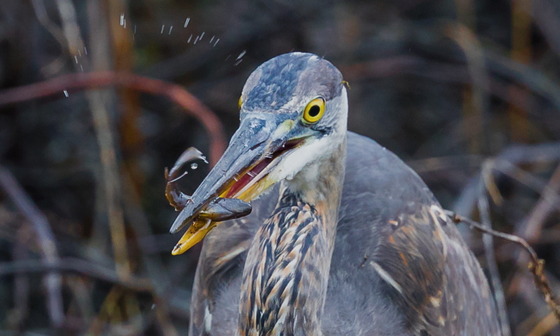 Great blue heron snapping up a bream (Jimmy Cash/Georgia Nature Photographers Association)
In March, we talked about getting outdoors at DNR wildlife management and public fishing areas. But let’s take a closer look at the fins-and-feathers side of that list.
Georgia’s 11 public fishing areas offer prime angling, of course. They also have amenities varying from docks and trails to bathrooms and picnic tables.
But it's easy to miss how birdy PFAs are. Their mix of habitats attracts a lot of species.
For example, sightings via the online database eBird show that if you want to see American coots, Silver Lake is golden (more than 10,000 coot sightings since January 2000). Likewise, Ocmulgee is big on barn swallows, blue grosbeaks and summer tanagers add a splash of color at Marben PFA, and – except during summer – ring-billed gulls can be almost common on Rocky Mountain PFA.
Some of the birds seen most often on other PFAs include anhingas at Paradise, great blue herons at McDuffie, double-crested cormorants at Big Lazer, great egrets at Flat Creek, yellow-rumped warblers at Dodge County, red-winged blackbirds at Evans County and pine warblers at Hugh Gillis.
Georgians 16 to 64 can bird, fish, hike and paddle on a PFA for $5 a day or $15 a year. A fishing license provides access. It also returns to wildlife work statewide the license fee plus about double that amount in federal excise taxes paid by anglers.
 Monarch butterfly (Denise Shepherd/DNR)
By ETHAN HATCHETT
Want to help DNR with research? Sign up for an iNaturalist account and take photos of the invertebrates you see each day, from spiders and worms to butterflies and snails.
Those reports can be fed into DNR’s Georgia Invertebrates project, a first-ever agency effort that collects observation data from the iNaturalist community. The goal is to better understand and conserve rare native species and map their movements.
Anna Yellin, an entomologist with DNR’s Wildlife Conservation Section, said that data like this wasn’t attainable before iNaturalist. And with the extreme diversity involved with terrestrial invertebrates, no researcher can become familiar with every taxonomic group.
“That makes networking and sharing information necessary,” Yellin said. “iNaturalist is a way to crowdsource the surveys and network with the specialists to help identify more species.”
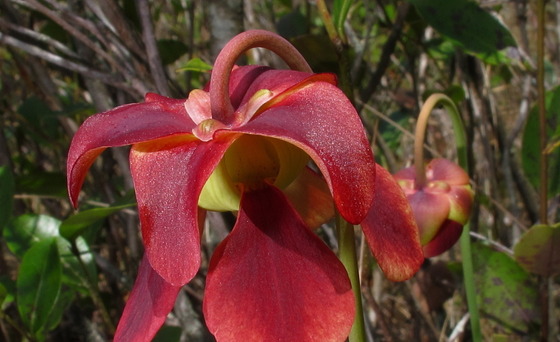 Sweet pitcherplant (Alan Cressler)
BEYOND INVERTEBRATES
DNR has also started using iNaturalist to record all species of conservation concern, such as trispot darters and sweet pitcherplants, in its Georgia Tracked Species project.
Meanwhile, small mammals like the eastern spotted skunk and southeastern pocket gopher are being mapped in the agency’s Georgia Small Mammals project.
The growing reservoir of iNaturalist data is another source DNR can use to help inform conservation decisions and overall management.
TAKING PART
- Log into your iNaturalist account (or create one).
- Then, using your computer (the following action is not available on the app), go to Georgia Invertebrates, Georgia Tracked Species or Georgia Small Mammals.
- In your member settings, “trust” the project and, depending on the project, select "Yes, for any of my observations” or “Yes, no matter who adds the observation to the project.” This allows biologists to access the data created by your observations, whether reported by computer or a mobile device.
Ethan Hatchett is a communications assistant in the DNR's Wildlife Conservation Section.
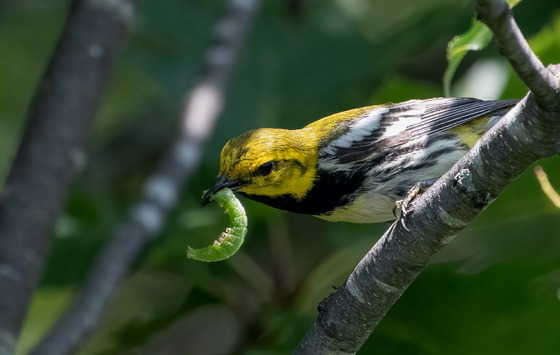 Black-throated green warbler with a caterpillar (Adobe Stock)
By TERRY W. JOHNSON
Recently while sitting outside with a friend, I noticed a tiny green larvae crawling up my shirt sleeve. The insect had fallen from the pale green leaves of a nearby oak.
It was a reminder that Nature is preparing a banquet for millions of northbound songbirds migrating back to their breeding grounds.
During the next several weeks, scores of different species of migratory songbirds such as warblers, vireos and thrushes will arrive in Georgia. While some will stay and nest here, most will quickly resume their journey.
Many of these birds are stopping to refuel and rest before moving on. These stopover sites are keyed to food. But it doesn’t include your feeders. The attraction is a living buffet in the treetops.
These migrants are seeking the larvae of moths and butterflies – better known as caterpillars – in addition to other small arthropods and their larvae. …
Read Terry’s column to explore this topic and how to up your yard’s larvae load.
Terry W. Johnson is a retired DNR manager and executive director of TERN, friends group of the Wildlife Conservation Section. Check out past columns and his blog. Permission is required to reprint a column.
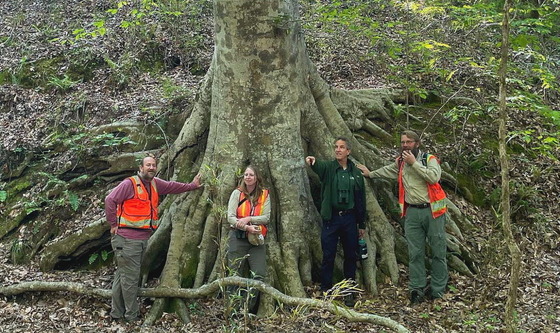 Real Estate Chief Steve Friedman, third from left, with other DNR staff at a massive beech tree (DNR)
You’re much more likely to have hiked, fished or hunted places that Steve Friedman helped protect than to have heard his name. Quiet-mannered and bound for retirement at the end of April, DNR’s Real Estate chief has forged a wildlands legacy. In his 19-year career, Friedman negotiated deals and engaged partners vital to acquiring more than 250,000 acres. All of this public land is open for outdoor recreation; much of it is critical to preserving rare species and habitats. Friedman's career highlights include building out a lower Altamaha River wildlife corridor, as well as helping acquire Alapaha River Wildlife Management Area near Ocilla, expand Ohoopee Dunes, Pigeon Mountain and Dawson Forest WMAs, cobble together state ownership of Paulding Forest WMA near Rockmart, and connect tracts targeted by the Gopher Tortoise Conservation Initiative to keep Georgia’s state reptile off the Endangered Species Act list. “Georgia’s wildlife, habitat and outdoor recreation are in a better place now thanks to Steve’s efforts with our department,” DNR Deputy Commissioner Trevor Santos said. See Names in the News (below) for details on the next Real Estate chief.
Red-cockaded woodpeckers are taking to Sprewell Bluff ... again. DNR senior wildlife biologist Nathan Klaus said four of the six woodpeckers moved from Fort Stewart to the middle Georgia wildlife management area in December "stayed put and paired up," meaning the endangered birds reintroduced to Sprewell Bluff after a 50-year absence could have chicks this spring ("Rare return," December).
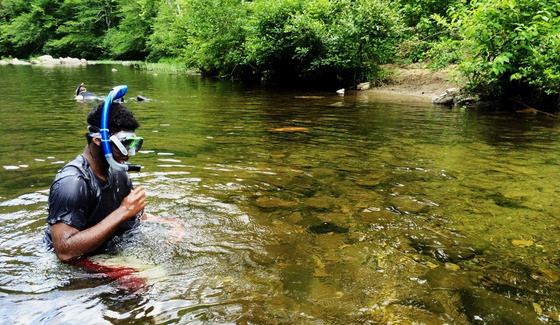 Snorkeling on the Conasauga River (Holly Krake/USFS)
Did someone say conservation lands? Among other work, the latest Georgia Outdoor Stewardship Program grants will help fund a 2,197-acre expansion of Treat Mountain Wildlife Management Area near Cedartown and 183 acres that add a mile of river frontage and boost the size of Conasauga River WMA in Murray County.
Six wildlife viewing projects announced by DNR’s Wildlife Resources Division will receive small grants to help Georgians see and learn about native animals and plants. Projects vary from viewing blinds at Talking Rock Nature Park in Pickens County to a canoe/kayak launch at Big Haynes Creek Nature Center in Conyers and new binoculars for youth at Burton 4-H Center on Tybee Island.
Resist the urge to “rescue” young birds, rabbits or deer and realize that the most helpful response is to leave the animal alone for at least 24 hours. A parent is usually close by, said DNR Urban Wildlife Program Manager Kaitlin Goode, and moving a young animal out of its natural environment and into your home often “takes away their ability to then survive in the wild, where they belong.”
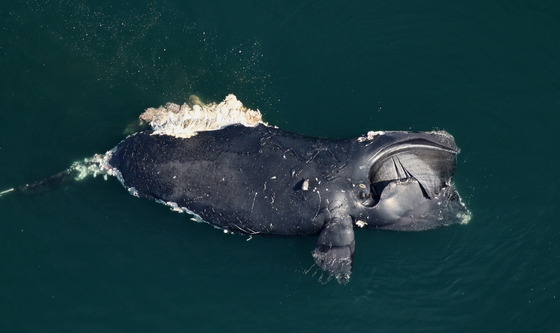 Scavenged right whale carcass off Virginia coast (CMARI/NOAA permit 24359)
Another North Atlantic right whale – a mom that calved this year – has died. The adult cataloged as no. 1950 was found floating 50 miles off the Virginia coast March 30. Her calf, last documented with its mother off Fernandina Beach, Fla., on Feb. 16, was not seen near the carcass and is considered by NOAA a “seriously injured dependent calf” in the ongoing Unusual Mortality Event for right whales.
Mussel monitoring in the lower Flint River basin, including modeling stream flows and mapping shoal depths, will gauge the impact of low flows on the basin’s mussels, some of which are rare. The three-year effort – awarded a federal grant and including DNR’s Freshwater Biodiversity Program, the Georgia Water Planning and Policy Center at Albany State University and others – also will sync with work to explore how irrigation can be used to steady flows and still support farming.
Would-be spelunkers can sign up for tours of Sitton’s Cave at Cloudland Canyon State Park. For these subterranean adventures near Rising Fawn, be ready to go deep, get muddy and see sights from soda straw stalactites to cave salamanders.
 Argentine black and white tegu (Dustin Smith)
Quick hits:
- If you see a tegu in Toombs or Tattnall counties, tell DNR to help eradicate these big, invasive lizards from the wild in that part of southeast Georgia.
- See a snake? Give it the space it needs and follow these tips from state herpetologist Daniel Sollenberger.
- See a black bear? Realize they prefer to avoid you so make noise, hike with others, never approach the animal and always be BearWise.
- Over 300 anglers landed a Georgia Angler Award certificate, T-shirt and cap last year: Here’s how you can this year.
- For those simply fishing for fine eating, DNR is stocking thousands of trout, from an average size of 9-10 inches to heftier fish up to 14 inches long.
- DNR’s Outdoors Beyond Barriers program aims to provide Georgians who have impaired mobility the tools, resources and access to enjoy fishing, hunting, wildlife viewing and other outdoor recreation.
Names in the news: DNR 18-year veteran Brent Womack is moving from regional Game Management supervisor in northwest Georgia to DNR chief of Real Estate at the agency’s Atlanta headquarters, following the retirement of current Chief Steve Friedman. Womack has worked closely with the Real Estate office, serving as the regional lead on acquisitions including Paulding Forest, Sheffield and Crockford-Pigeon Mountain wildlife management areas, and the Tallapoosa River and Treat Mountain tracts in the Dugdown Corridor. Eleven-year-old Quinn McMichael of Decatur accepted his 59th and final Junior Ranger badge in March. Quinn began earning the badges on trips with his father during the COVID pandemic and kept going until he completed the site-specific Ranger programs at all 59 state parks and historic sites that offer them.
WHAT YOU MISSED ...
In the previous Georgia Wild:
- Prehistoric fish in the Oconee
- Native honeysuckle you need
- Keep watch for spotted skunks
"Right whale mom found dead off Virginia, calf not expected to survive," CBS News
"Entanglement behind declining whale numbers," Macquarie University (study in Proceedings of the Royal Society B)
"New DNR leadership passionate about hunting, fishing," Georgia Outdoor News
"DNR: What to do when you see a snake," Grice Connect and others, including Cordele Dispatch and Marietta Daily Journal
"Saga of kinder, gentler Whigham Rattlesnake Roundup," The Albany Herald
"Debate over Flint fishing rights leads to legislative action," WABE-FM (90.1, Atlanta). Related: Georgia Recorder.
"DNR making it easier for people with disabilities to hunt, fish," WSB-TV (Atlanta)
"Nature Conservancy protects 8k acres in Mobile-Tensaw Delta," The Bama Buzz
"What is a right whale? NYT sends puzzlers to Google," The Indianapolis Star
"DNR awards Wildlife Viewing Grants," Morgan Citizen (Madison) and others, including AllonGeorgia
"64th annual Whigham Rattlesnake Roundup," WALB-TV (Albany)
"New England Aquarium reacts to new tech notifying vessels speeding in whale zones," CapeCod.com
(audio) "Complicated truths about offshore wind, right whales," Science Friday
"Robotic dog disguised as coyote will haze wildlife at airport," Outdoor Life
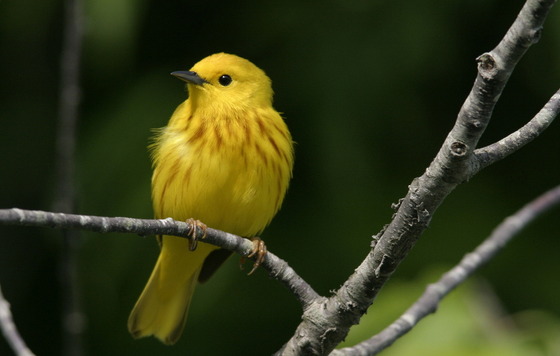 Yellow warbler (Ty Ivey/Georgia Nature Photographers Association)
Spring draws thousands of birds to Georgia from far-flung places. Mornings become symphonies of dynamic birdsong from migrants ready to breed. One confident melody proclaimed for all is “Sweet, sweet, I’m so sweet!” It’s the song of the yellow warbler, a tiny bird that migrates in spring from southern Central and northern South America to the U.S. and Canada (in Georgia, the species breeds in the extreme northern part of the state). At this time of year, yellow warblers are found on treetops in wet thickets and along roadsides throughout the state. Of the 30 species of warblers that breed in or migrate through Georgia, few offer as easy viewing as the yellow warbler. Males sport egg-yolk colored plumage with streaks of light chestnut on the breast. Females lack the streaks, yet are just as striking.
- Ethan Hatchett
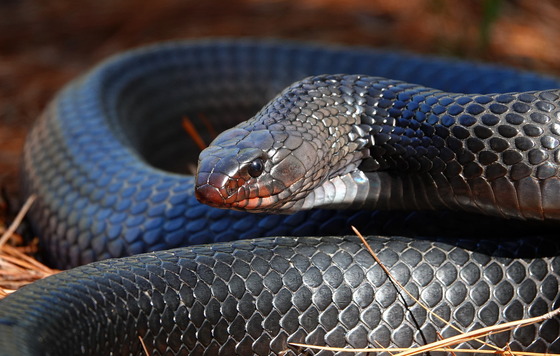 Eastern indigo (Matthew Moore/DNR)
Longleaf pine savannas conjure up images of gaping gopher tortoise burrows, red-cockaded woodpeckers flitting high in the pines and wildflowers carpeting the forest floor. But one secretive yet as iconic resident is the eastern indigo snake. These apex predators are North America’s longest native snake, with adult males reaching about 7 feet. Indigos are as beautiful as they are big, their thick black bodies revealing iridescent purple and blue highlights and their red to orange chin and cheeks providing a colorful contrast. Read about indigos in this blog post.
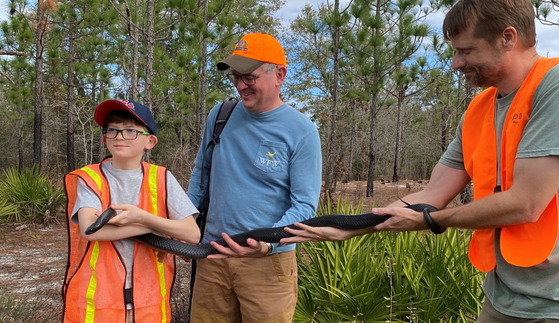 Father and son Mark (center) and Garrett Jarboe with an indigo and DNR’s Matthew Moore during a Weekend for Wildlife auction trip. (Erin Cork/DNR)
|